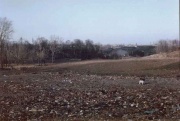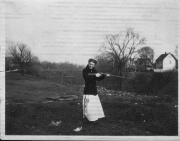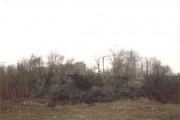|
| |||||
Ravines
From Brooklyn Centre Wiki
Brooklyn Centre had, at one time, a deep ravine that cut through the land in an east/west orientation from approximately West 25th St. between Forestdale Avenue and Denison Avenue, down to Jennings Avenue.
The sides of this ravine were quite steep. Karl Sturtevant, son of Mary Stanton Fish who appears in the photo at the right, says that he would frequently go down into the ravine but the only way down was to slide on his butt. The depth of the ravine is unknown but an estimate of 30 feet can be made from the text that appeared under a photo of a bridge in Riverside Cemetery that gives it's height at 27'. Mr. Sturtevant also provided some other details about the ravine such as the fact that at one time it had been surrounded by fencing, presumably to either prevent access or to prevent accidents as it was a huge attraction for the children in the area.
The ravine was spring fed -- the spring being located on the hill behind Mr. Sturtevant's house (this house having once been occupied by his grandfather, John Stanton Fish, the son of the original settler Ebenezer Fish.)
At the bottom, in dry weather, there would only be a small slow moving stream. In wet weather, however, a pond would form of sufficient depth that a horse-drawn wagon (minus the horse, of course) that had been pushed in there from the edge by some naughty boys dissappeared from view. The pond also provided a source of ice for one of the local ice houses. One hopes they didn't use it for cooling their drinks!
In 1939, George Davis' article[1] about the Brooklyn Centre area mentions an Opera House:
"Brooklyn had a ground-floor opera house when most theatres were second-floor halls like the Academy of Music downtown in Cleveland. It was near the Denison Avenue corners once called Brooklyn Centre. Inexpensively, this opera house floor was made to slant down to the orchestra pit, by building on the edge of a hill. Town coucil met in the opera house. A bakery moved in later. Now the building is gone. But nearby stands the old hall built by Brooklyn veterans of the Civil War."
-- Beautiful Brooklyn by George Davis
The Cleveland Press, February 28, 1939
All hills in the area have been smoothed out for the convenience of roads and housing, however, because of the nearness of the opera house to the ravine (the GAR hall was at the corner of Garden Avenue and West 25th Street), is it possible that the builders were able to somehow incorporate the sides of the ravine for this construction?

Facing north (just north of Denison Ave. and west of West 15th) The rubbish that was dumped here served as a landfill. Originally, there was a deep ravine between Riverside Cemetery and the property on West 15th Street
Speaking of changing the terrain, in the late 1920's an effort began to fill in the ravines starting at it's western end. Trucks began dumping rubbish as fill material. Surrounding neighbors became very upset with this activity due to the risk of fire, smell, and probably vermin that were drawn to the area too. As the depths were filled in, the trucks would use this as a platform for reaching further and further to the east. Often the trucks would become stuck as their tires sunk into the fill and would need to be towed out.
Who actually instigated this filling in process is unknown at this time, though the portion of the ravine that lay between Fern Court and Jennings Avenue was purchased by The Cleveland Railway Company in the mid-1920's from the then owner, George Sheer of Sheer Brothers Iron Fence Company. Presumably, they would have been the ones to fill in their portion of the ravine. Cleveland Railway was purchased by the City of Cleveland in 1942 and renamed as the Cleveland Transit System (CTS).
Exactly why there was a need to fill in the ravine is uncertain. Was it because of the danger it posed? Or to create additional land for building housing? Because no housing was ever constructed over this landfill, other than the Forestdale Apartments at the western end, it is more likely the ravine provided a handy place for the Cleveland Railway Co. to dump construction materials that accumulated during their installation of streetcar tracks around the city of Cleveland. The eastern terminus of the ravine was the last part to be filled in and by that time (the 1950's) had become a dumping ground for pure rubbish by the city.
The sad part of all this ravine filling is that it seems that a park either existed within it, as evidenced by references to the "park addition" in several old 1888 deeds, or was planned. An old map indicates the stream running through the ravine led down to the large pond within Riverside Cemetery that we know was used for boating. Back in those days it must have been a scenic place, indeed. I was an eyewitness to the scenic splendor that was there in the 1950's before the dumping had progressed much further than a few hundred feet north from Denison Avenue just west of West 15th St. A small stream meandored between many small grassy hillocks, some of which had trees growing out of them. The hillocks not being much more the 4 foot in diameter, they were like green polka dots strewn along the valley floor. As children, we could jump from one to another of these, thereby avoiding stepping into the water. The sides of the ravine here were covered in trees and weren't quite as steep as the western part, but still required the necessity to be careful as you traversed the footpaths, worn by generations of people coming down into this area. There was an old spring located about a dozen feet from the top edge here -- some enterprising unknown person had inserted an iron pipe horizontally into the side of the hill which allowed the spring water to stream from the pipe and allowed it to be conveniently emptied into a bucket or jug.
Once filled in entirely, the leveled ravine land became the site of tennis courts and a large playground behind East Denison Elementary School. Mostly though, it remains vacant land.
What were the origins of these ravines? What mechanism of nature created them? It is known that glaciers covered northern Ohio, most recently 10,000 years ago. Meltwater, as the glaciers receeded, may have had the force necessary to carve these gouges into the earth.
NOTES
- ↑ Davis, George, Beautiful Brooklyn, February 28, 1939 issue of The Cleveland Press
Help support this website by visiting some of the Ads provided by Google.


